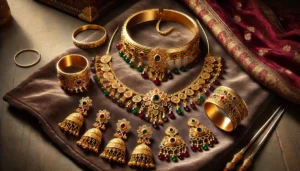Discover how textile and fabric-based jewelry is revolutionizing sustainable fashion. Learn how these unique pieces are crafted and their growing appeal.
Textile and fabric-based jewelry is redefining sustainable fashion, bringing creativity, innovation, and eco-consciousness together in an unexpected and captivating way. Moving beyond traditional metal and gemstone options, artisans are turning to soft materials like cotton, jute, felt, and recycled fabrics to create stunning, lightweight jewelry that is both stylish and sustainable. With a growing emphasis on environmental responsibility in the fashion industry, fabric-based jewelry is emerging as a unique and ethical alternative, appealing to a diverse audience seeking distinctive fashion statements.

The Emergence of Textile and Fabric-Based Jewelry
The concept of textile and fabric-based jewelry is not entirely new; it draws inspiration from age-old practices where communities around the world used natural fibers and textiles to adorn themselves. However, in recent years, this type of jewelry has gained significant traction in mainstream fashion circles, thanks to the push for sustainability and ethical fashion. According to fashion historian Anita Patel, “fabric-based jewelry represents a shift towards valuing materials that are renewable, biodegradable, and have a lower carbon footprint.”
The versatility of textile jewelry is another reason for its rising popularity. From statement necklaces made of braided cotton to intricately woven jute earrings and patchwork fabric cuffs, these pieces offer endless design possibilities. The use of vibrant colors, unique textures, and innovative weaving techniques allows designers to craft accessories that are not only visually appealing but also rich in cultural significance.
How Textile and Fabric-Based Jewelry is Crafted
Creating fabric-based jewelry involves a blend of traditional craftsmanship and modern design techniques. Many artisans start by selecting high-quality, sustainable fabrics—such as organic cotton, hemp, silk, or even repurposed materials like denim or sari fabrics. These textiles are then cut, shaped, and treated to create various jewelry elements. Techniques like braiding, knotting, stitching, and embroidery are commonly used to give the pieces form and structure.
Textile jewelry often incorporates other sustainable materials such as wood, shells, or seeds to add depth and dimension. Designers might also use natural dyes and eco-friendly adhesives to ensure the final product is entirely sustainable. Jewelry designer and environmental advocate Sasha Morgan pointed out that “every step in the creation process of fabric-based jewelry, from material selection to finishing touches, is an opportunity to make a more sustainable choice.”
The Growing Appeal of Sustainable Jewelry
The demand for textile and fabric-based jewelry is driven by a growing desire for sustainable fashion. Today’s consumers are increasingly concerned about the environmental impact of their purchases and are opting for products that align with their values. Fabric-based jewelry fits perfectly within this mindset, offering a stylish yet conscious alternative to traditional jewelry.
Another key appeal of textile jewelry is its comfort and lightweight nature. Unlike heavy metal pieces, fabric-based jewelry can be worn for extended periods without discomfort. This quality makes it particularly popular for summer wear and casual styling, where comfort and style go hand-in-hand. Moreover, the customizable nature of textile jewelry means that pieces can be tailored to suit specific tastes or complement particular outfits, adding a unique touch to any wardrobe.
The Future of Fabric-Based Jewelry
Fashion industry experts believe that fabric-based jewelry has significant growth potential, especially as more consumers and brands embrace sustainable practices. The trend is also gaining momentum thanks to increased visibility on social media and e-commerce platforms, where independent artisans and small-scale designers showcase their creations to a global audience.
Ethical fashion consultant Monica Vance noted that “textile jewelry represents a convergence of art, culture, and sustainability—three elements that modern consumers find increasingly attractive.” She also emphasized that as fashion continues to evolve toward more sustainable practices, fabric-based jewelry will likely become a staple in the accessory market.
A New Era of Fashion Accessories
Textile and fabric-based jewelry is more than just a trend; it is a reflection of the changing values in fashion. As more people seek accessories that are not only beautiful but also ethical and sustainable, the appeal of fabric-based jewelry will continue to grow. With a focus on craftsmanship, innovation, and environmental responsibility, this unique form of jewelry is set to make a lasting impact on the fashion world.











